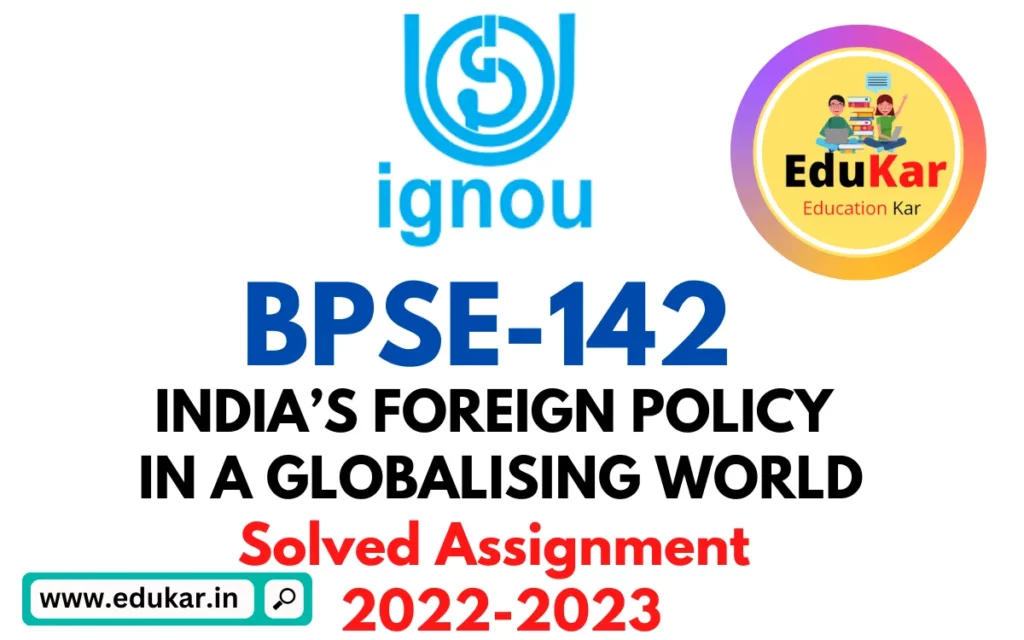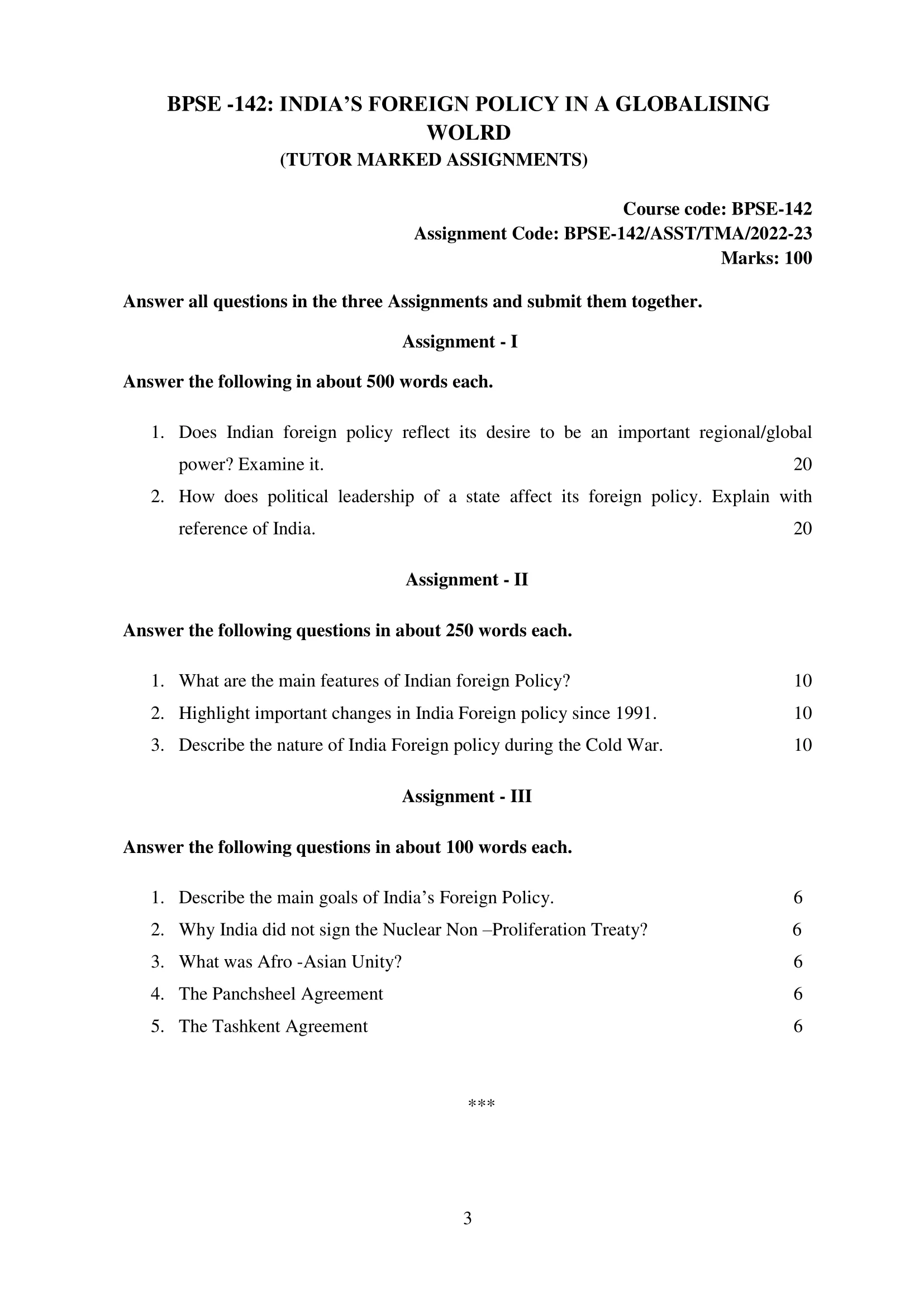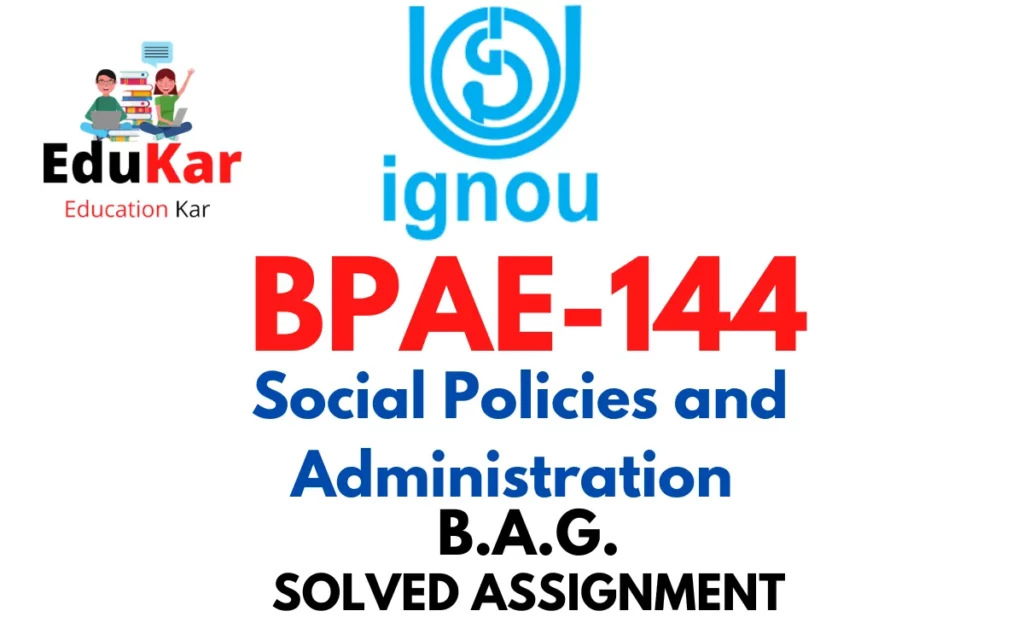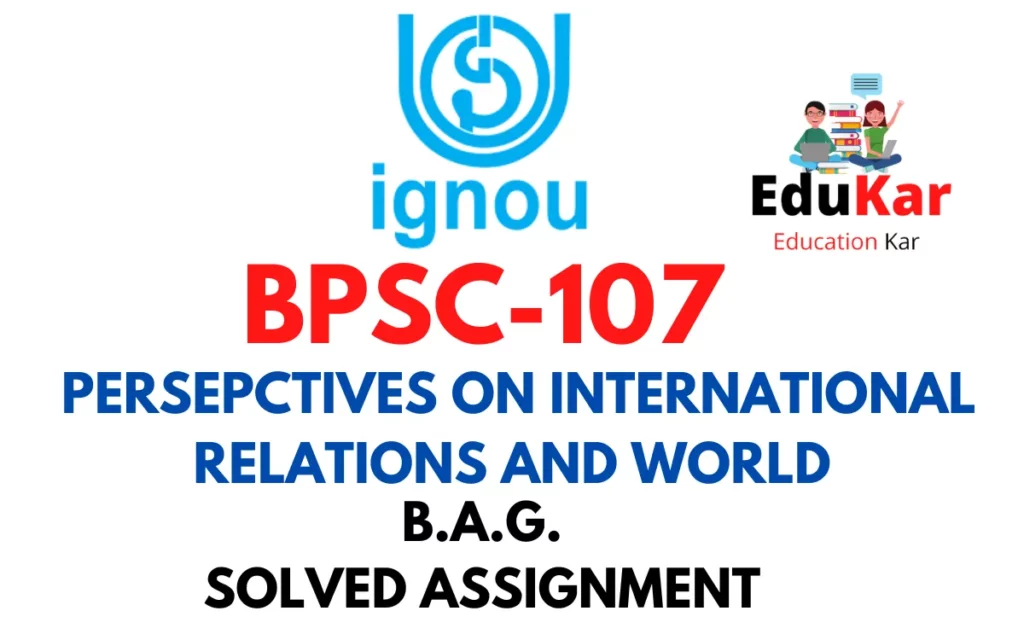Contents
- 1 Assignment – I
- 2 Answer the following in about 500 words each.
- 3 1. Does Indian foreign policy reflect its desire to be an important regional/global power? Examine it.
- 4 2. How does political leadership of a state affect its foreign policy. Explain with reference of India.
- 5 Assignment – II
- 6 Answer the following questions in about 250 words each.
- 7 1. What are the main features of Indian foreign Policy?
- 8 2. Highlight important changes in India Foreign policy since 1991.
- 9 3. Describe the nature of India Foreign policy during the Cold War.
- 10 Assignment – III
- 11 Answer the following questions in about 100 words each.
- 12 1. Describe the main goals of India’s Foreign Policy.
- 13 2. Why India did not sign the Nuclear Non –Proliferation Treaty?
- 14 3. What was Afro -Asian Unity?
- 15 4. The Panchsheel Agreement.
- 16 5. The Tashkent Agreement.

| Title | BPSE-142: IGNOU BAG Solved Assignment 2022-2023 |
| University | IGNOU |
| Degree | Bachelor Degree Programme |
| Course Code | BPSE-142 |
| Course Name | INDIA’S FOREIGN POLICY IN A GLOBALISING WORLD |
| Programme Name | Bachelor of Arts (General) |
| Programme Code | BAG |
| Total Marks | 100 |
| Year | 2022-2023 |
| Language | English |
| Assignment Code | BPSE-142/ASST/TMA/2022-23 |
| Last Date for Submission of Assignment: | For June Examination: 31st April For December Examination: 30th September |

Assignment – I
Answer the following in about 500 words each.
1. Does Indian foreign policy reflect its desire to be an important regional/global power? Examine it.
Ans: Indian foreign policy has been shaped by a desire to be an important regional and global power, and this is reflected in the various initiatives and actions taken by the Indian government over the years. In the post-independence era, India has pursued a non-aligned foreign policy that aimed to maintain a balance between the major powers of the world and to promote its own interests in the region. However, in recent years, India has become more assertive in its foreign policy and has taken a more proactive role in shaping regional and global affairs.
One of the key indicators of India’s aspirations as a regional power is its focus on building stronger relationships with its neighbors. In recent years, India has made significant investments in infrastructure, trade, and security initiatives in countries like Bhutan, Nepal, Sri Lanka, and Bangladesh. These efforts aim to promote stability and security in the region, as well as to increase India’s economic and political influence. Additionally, India has also sought to build closer ties with countries like Japan, Australia, and the United States, which it views as important partners in shaping regional and global affairs.
Another aspect of Indian foreign policy that reflects its desire to be an important power is its focus on strengthening its military capabilities. India has made significant investments in modernizing its military and has sought to develop a more robust capability to respond to security threats in the region. This has included initiatives such as the development of nuclear-powered submarines, the acquisition of advanced fighter jets, and the development of a strong missile defense system. Additionally, India has also sought to expand its role in international peacekeeping operations, which reflects its commitment to contributing to global security and stability.
India’s desire to be an important global power is also reflected in its efforts to engage with major international organizations and forums. India has been actively participating in the United Nations and has sought to play a more prominent role in international organizations like the World Trade Organization, the International Monetary Fund, and the World Bank. Additionally, India has also been seeking a permanent seat on the United Nations Security Council, which reflects its aspirations to play a more influential role in shaping global affairs.
However, there are also challenges that India faces in its pursuit of regional and global power. One of the key challenges is its relationship with its neighbors, particularly Pakistan. Despite efforts to improve ties, the long-standing territorial dispute over Kashmir remains a major source of tension between the two countries. Additionally, India also faces competition from China, which has been rapidly expanding its economic and military influence in the region.
2. How does political leadership of a state affect its foreign policy. Explain with reference of India.
Ans: Political leadership is one of the most important factors that shapes the foreign policy of a state. The decisions and actions of leaders can have significant impact on the direction and priorities of a state’s foreign policy, and can also influence the way that other countries perceive and interact with that state. In the case of India, the political leadership has played a major role in shaping its foreign policy, both in terms of its objectives and the manner in which these objectives are pursued.
One of the key ways that political leadership affects foreign policy is through the setting of priorities and objectives. In India, different political leaders have pursued different foreign policy priorities, depending on their political ideologies and personal beliefs. For example, some leaders have placed greater emphasis on strengthening economic ties with other countries, while others have focused more on security and strategic concerns. These different priorities can have a significant impact on the way that India interacts with other countries, and can also influence the level of investment and resources that the country directs towards its foreign policy goals.
Another way that political leadership affects foreign policy is through the style and tone of interactions with other countries. Different leaders may take different approaches to diplomacy and negotiations, which can have a significant impact on the way that other countries perceive and respond to India. For example, some leaders may adopt a more conciliatory and cooperative approach, while others may take a more confrontational and aggressive stance. These different approaches can have a major impact on the success of India’s foreign policy initiatives, and can also influence the level of support that the country receives from other countries and international organizations.
In the case of India, political leadership has also had a major impact on the country’s relationships with its neighbors. For example, under the leadership of Prime Minister Atal Bihari Vajpayee, India took a more proactive approach to improving relations with Pakistan, which led to a series of high-level visits and negotiations. This helped to improve the relationship between the two countries, and paved the way for a more productive and cooperative relationship in the future. Similarly, under the leadership of Prime Minister Narendra Modi, India has taken a more assertive stance towards China, reflecting his personal beliefs and political priorities.
However, political leadership can also pose challenges to foreign policy. For example, leaders may have personal interests or biases that can interfere with the pursuit of foreign policy goals. Additionally, political leaders may also face domestic constraints, such as opposition from other political parties or interest groups, which can limit their ability to pursue certain foreign policy initiatives. In India, this has sometimes led to tensions and disagreements between the government and opposition, which can have a negative impact on the country’s foreign policy.
Assignment – II
Answer the following questions in about 250 words each.
1. What are the main features of Indian foreign Policy?
Ans: Indian foreign policy has been shaped by a number of factors including its history, geography, economic interests, and political values. Some of the main features of Indian foreign policy are:
- Non-alignment: India has maintained a policy of non-alignment and has refrained from joining any military alliance.
- Peaceful Coexistence: India has been a strong advocate of peace and has worked towards promoting regional and global peace through diplomacy and peaceful means.
- Strategic Autonomy: India has maintained a policy of strategic autonomy, where it determines its foreign policy based on its own national interests, rather than being influenced by any other country.
- Look East Policy: India has shifted its focus towards the East and has been building strategic partnerships with countries in the Asia-Pacific region.
- Economic Diplomacy: India has been actively engaged in economic diplomacy, using trade and investment as key instruments of foreign policy to enhance its economic growth and development.
- Focus on Neighbourhood: India has placed a high priority on its neighbourhood and has been working to build strong relationships with its neighbours, including through initiatives such as the South Asian Association for Regional Cooperation (SAARC).
- Multilateralism: India has been a strong supporter of multilateralism and has actively participated in various international organizations such as the United Nations (UN), World Trade Organization (WTO), and the World Health Organization (WHO).
- Defence Diplomacy: India has been strengthening its defence diplomacy and has been working to enhance its defence cooperation with countries in the region and beyond.
2. Highlight important changes in India Foreign policy since 1991.
Ans: India’s foreign policy underwent significant changes after the economic liberalization and globalization drive of 1991. Some of the important changes in India’s foreign policy since 1991 are:
- Increased Engagement with the World: India has increased its engagement with the world, both economically and politically, by participating in various international organizations and multilateral forums.
- Focus on Economic Diplomacy: India has placed a greater emphasis on economic diplomacy and has been actively seeking to enhance its trade and investment links with other countries.
- Look East Policy: India has shifted its focus towards the East and has been building strategic partnerships with countries in the Asia-Pacific region, with the aim of strengthening its economic and security interests.
- Greater Emphasis on Defence Diplomacy: India has increased its defence diplomacy and has been working to enhance its defence cooperation with countries in the region and beyond.
- Strategic Partnership with the United States: India has developed a strategic partnership with the United States and has been working closely with the US on a range of issues, including defence, trade, and counter-terrorism.
- Engagement with China: India has been engaging with China to address various bilateral and regional issues, while also seeking to balance its relationship with the US and other major powers.
- Focus on Neighbourhood: India has placed a high priority on its neighbourhood and has been working to build strong relationships with its neighbours, including through initiatives such as the South Asian Association for Regional Cooperation (SAARC).
- Nuclear Diplomacy: India has pursued a policy of nuclear diplomacy and has sought to address international concerns about its nuclear program while also working to enhance its nuclear security.
3. Describe the nature of India Foreign policy during the Cold War.
Ans: India’s foreign policy during the Cold War was shaped by the country’s non-aligned stance and its desire to maintain strategic autonomy in the face of intense competition between the United States and the Soviet Union. Some key features of India’s foreign policy during the Cold War include:
- Non-alignment: India maintained a policy of non-alignment during the Cold War and refused to align itself with either the US or the Soviet Union.
- Neutrality: India maintained a neutral stance in the global conflict between the two superpowers and sought to promote peace and stability in the region and the world.
- Strategic Autonomy: India pursued a policy of strategic autonomy, where it determined its foreign policy based on its own national interests, rather than being influenced by either the US or the Soviet Union.
- Focus on Neighbourhood: India placed a high priority on its neighbourhood and worked to build strong relationships with its neighbours, including through initiatives such as the South Asian Association for Regional Cooperation (SAARC).
- Development Diplomacy: India used development diplomacy as a key instrument of foreign policy to promote economic growth and development, both domestically and internationally.
- Peaceful Coexistence: India sought to promote peaceful coexistence between the two superpowers and played a role in resolving regional conflicts, including in the Korean War and the Vietnam War.
- Humanitarian Assistance: India provided humanitarian assistance to countries in need, including those affected by conflict, natural disasters, and other crises.
Assignment – III
Answer the following questions in about 100 words each.
1. Describe the main goals of India’s Foreign Policy.
Ans: The main goals of India’s foreign policy are to promote national security and economic interests, to foster good relationships with other countries, and to play a leadership role in regional and global affairs. India seeks to protect its sovereignty and territorial integrity, and to promote stability and security in its neighborhood and beyond. At the same time, India is focused on increasing its economic engagement with other countries, including through trade, investment, and cultural exchanges. Finally, India seeks to play a leadership role in regional and global affairs, including through its membership in organizations such as the United Nations and the Non-Aligned Movement, and its efforts to promote peace, stability, and sustainable development around the world.
2. Why India did not sign the Nuclear Non –Proliferation Treaty?
Ans: India did not sign the Nuclear Non-Proliferation Treaty (NPT) because it saw the treaty as discriminatory and contrary to its national security interests. The NPT divided the world into nuclear “haves” and “have-nots,” with only five countries recognized as nuclear-weapons states. India, which had a long history of pursuing a policy of nuclear disarmament, saw this division as unjust and inconsistent with the principles of equality and non-proliferation. Additionally, India felt that the NPT did not adequately address the security concerns of non-nuclear states, and that it did not provide sufficient guarantees against the use or threat of use of nuclear weapons. India therefore chose to pursue its own nuclear program, and has consistently maintained that it will not sign the NPT until it is revised to reflect the principles of non-discrimination and equality.
3. What was Afro -Asian Unity?
Ans: Afro-Asian Unity was a political movement that aimed to promote cooperation and solidarity among African and Asian countries in the mid-20th century. The movement emerged in the aftermath of World War II, as many countries in Africa and Asia were gaining independence from colonial rule and seeking to assert their autonomy in the international arena. Afro-Asian Unity sought to bring together these countries on the basis of shared experiences of colonialism and a common commitment to promoting peace, development, and cooperation. The movement was reflected in several international gatherings, such as the Bandung Conference in 1955, which brought together leaders from Asian and African countries to discuss common challenges and opportunities. Through these efforts, Afro-Asian Unity helped to lay the foundation for greater cooperation and collaboration between Africa and Asia in the decades that followed, and remains an important part of the global history of decolonization and international cooperation.
4. The Panchsheel Agreement.
Ans: The Panchsheel Agreement, also known as the Five Principles of Peaceful Coexistence, was a landmark agreement signed between India and China on April 29, 1954. The agreement was signed by Indian Prime Minister Jawaharlal Nehru and Chinese Premier Zhou Enlai and aimed to promote peace and stability between the two countries. The five principles of the agreement are mutual respect for each other’s territorial integrity and sovereignty, mutual non-aggression, mutual non-interference in each other’s internal affairs, equality and mutual benefit, and peaceful coexistence. The Panchsheel Agreement was seen as a significant step towards promoting peace and stability between India and China, however, tensions between the two countries continued to persist, leading to a border conflict in 1962. Nevertheless, the Panchsheel Agreement remains an important aspect of India-China relations and continues to shape the bilateral relationship between the two countries.
5. The Tashkent Agreement.
Ans: The Tashkent Agreement was signed on January 10, 1966, between India and Pakistan, following the end of the 1965 Indo-Pakistan War. The agreement was signed in Tashkent, the capital of the then-Soviet Union, with the Soviet Premier Alexei Kosygin serving as a mediator. The agreement aimed to resolve the conflict between India and Pakistan and establish peace between the two countries. The agreement outlined a ceasefire and the withdrawal of forces to pre-war positions, as well as the establishment of a code of conduct to avoid future conflicts. The Tashkent Agreement was seen as a significant step towards resolving the tensions between India and Pakistan and promoting peace in the region. However, it was not a long-lasting solution, as tensions between the two countries continued to persist in the decades following the agreement.
How to Download BPSE-142 Solved Assignment?
You can download it from the www.edukar.in, they have a big database for all the IGNOU solved assignments.
Is the BPSE-142 Solved Assignment Free?
Yes this is absolutely free to download the solved assignment from www.edukar.in
What is the last submission date for BPSE-142 Assignment?
For June Examination: 31st April, For December Examination: 30th October
















